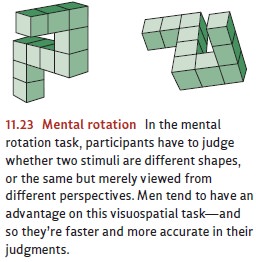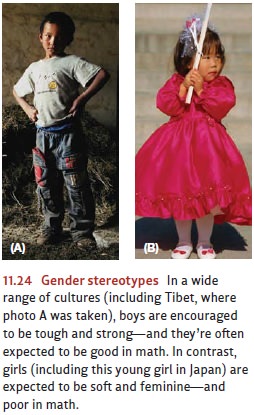Chapter: Psychology: Intelligence
Group Differences in IQ: Comparisons Between Men And Women
COMPARISONS BETWEEN MEN AND WOMEN
With
these preliminary points now established, we’re ready for the data—starting
with the difference between men and women. Of course, men and women do differ
in some ways. For example, men tend to be more physically aggressive than
women; women, in contrast, rely on social aggression (gossiping, or
ostracizing) more than men do. But men and women are also alike in many
ways—and so, as just one illustration, evidence makes it clear that there’s
virtually no difference between men and women in their effectiveness as leaders
or their competitiveness as negotiators (J. Hyde & Linn, 2006).
What
about intellectual abilities? Overall, neither sex is more intelligent than the
other; and there’s no reliable difference between men and women in their IQ
scores (e.g., Held, Alderton, Foley, & Segall, 1993; R. Lynn, 1994;
although see N. Brody, 1992). We do detect differences, though, when we
consider more specialized abilities. On average, men do better on certain tests
designed to measure visuospatial abilities, such as tests requiring mental
rotation (Figure 11.23). Men also do better on tasks that require them to
navigate through a virtual (computerized) three-dimensional environ-ment (like
the fictional worlds one must “travel through” in many computer games; Halpern,
Benbow, Geary, Gur, Hyde et al., 2007). Women, for their part, on average do
better on certain verbal tasks—especially tasks that require clear and fluent
writing (Halpern, 1992, 2000; Halpern et al., 2007; L. Levine et al., 1999).

These
differences are easily documented in the laboratory; but men and women also
differ in their intellectual achievement outside of the lab, and the
interpretation of this point has been a matter of controversy. To understand
the debate, let’s start with the fact that many studies have documented
differences between men and women in educational achievement—a so-called gender
gap. One study examined the test scores for 15-year-olds in 41 different
countries (Machin & Pekkarinen, 2008). In every country, girls outscored
boys in tests of reading; in most countries, boys outscored girls in tests of
mathematics. The data also showed that in both reading and mathematics, scores
for boys were more variable than
scores for girls; more boys than girls were likely to achieve scores rather
distant from (above or below) the average for their sex (W. Johnson, Carothers,
& Deary, 2008).
Another
study compared the SAT scores of 40,000 American high-school students. The
study showed that men (on average) did better than women on the math portion of
the test, even when the investigators limited their comparison to men and women
who had taken exactly the same high-school math courses and had expressed the
same degree of interest in mathematics (Benbow, 1988; Benbow, Lubinski, Shea,
& Eftekhari-Sanjani, 2000; for related data, see Halpern et al., 2007).
Other
considerations, however, complicate the comparison between the sexes. As one
concern, we probably shouldn’t be comparing men and women in terms of math
performance overall, because the gender comparison may depend on what type of
math we’re considering. For example, the advantage for men seems clearer for
tests that showcase spatial relations or geometry (Crawford & Chaffin, 1997;
Halpern et al., 2007; J. Hyde, 2005); for tests emphasizing computation, the
advantage goes to women (J. Hyde & Linn, 2006).
In
addition, some measures don’t show women falling behind in mathematics. For
example, National Science Foundation data indicate that men and women are
equally likely to take calculus in high school, and it’s the women who get
better grades (A. Gallagher & Kaufman, 2005). Similarly, America’s No Child
Left Behind (NCLB) legislation requires states to assess student progress annually.
A 2008 report on these assessments finds no difference between male and female
high-school students in their average level of math achievement, although the
scores for males continue to be somewhat more variable than the scores for
females—so that males are more likely than females to obtain scores well below
or well above the mean (J. Hyde, Lindberg, Linn, Ellis, & Williams, 2008;
W. Johnson et al., 2008).
What
about performance beyond high school? In college, men and women get equal math
grades (Bridgeman & Lewis, 1996), even when we match their math classes for
difficulty. Assessments of understanding of mathematical concepts in college
courses likewise show no difference between the sexes (J. Hyde & Linn,
2006).
What
lies behind all of these findings? For those studies that do detect sex
differences in educational performance, what’s the cause? And why is it that,
in the laboratory, men consistently have an advantage in visuospatial
reasoning? Some authors have suggested biological explanations for these facts,
often pointing to a possible link between spatial abilities and the male sex
hormone testosterone. In one study, for example, males who produced abnormally
low levels of testosterone showed impairments in spatial reasoning (Hier &
Crowley, 1982); in another study, older males (aged 60–75) showed dramatic
improvements in spatial reasoning after receiv-ing testosterone supplements
(Cherrier et al., 2001; Janowsky, Oviatt, & Orwoll, 1994; also see Van
Goozen, Cohen-Kettenis, Gooren, Frijda, & Can de Poll, 1995). But on the
other hand, several studies have failed to confirm these hormonal effects on
visu-ospatial performance, so any conclusions about this point must be
tentative (e.g., Halari et al., 2005; Hines et al., 2003; Moffat & Hampson,
1996; also see Halpern, 2000; N. Newcombe, 2007; Spelke, 2005).
A
different hypothesis focuses on cultural influences—including the important
observation that in most Western cultures, young boys receive much more support
and encouragement than young girls do for work in mathematics (Figure 11.24).
Indeed, many people (including parents and teachers) seem to believe that women
are ill suited for math and expect women not to do well in this domain
(Halpern, 1992). Thus, parents expect their sons to do better in math courses
than their daughters do (Frome & Eccles, 1998) and often attribute their
sons’ success in math to ability while attributing their daughter ’s success in
math to hard work (Parsons, Adler, & Kaczala, 1982). Even young children
endorse these stereotypes (C. Steele, 2003) and, by middle adolescence, girls
seem to receive less support from their peers for science- and math-related
activities than boys do (Stake & Nickens, 2005) .

Do
these social factors influence how children behave and what they achieve?
Studies show that women perform less well on some math tests if they’re asked,
at the start of the test, simply to record their gender on the test form.
Presumably, this serves to prime the relevant stereotype, and this undermines
performance (Ambady, Shih, Kim, & Pittinsky, 2001; we’ll go into greater
detail about “stereotype threat” shortly). Similarly, sex differences in test
scores are powerfully influenced by factors in the context that shape the test
takers’ expectations. In one study, male and female college students all took a
math test. Half of the students were told that this test had shown sex
differences in the past; in this group, male students outperformed the females.
The other half of the students were told that the test had been shown in the
past to be gender fair; in this group, there was no sex difference in
performance (R . Brown & Josephs, 1999; Crawford & Chaffin, 1997; Halpern
et al., 2007).
Hypotheses
emphasizing the role of experience and encouragement find further support in
the fact that visuospatial skills can be markedly improved through practice—a
point that has been documented in a wide range of studies (Halpern et al., 2007).
In one experiment, male and female college students practiced playing an action
video game (Medal of Honor: Pacific
Assault) for a total of 10 hours. This practice improved the spatial skills
of all participants, but the improvement was greater in women and led to a
clear reduction in the difference between the sexes (Feng, Spence, & Pratt,
2007).
Indeed,
in light of the studies showing the positive influence of instruction,
experi-ence, and encouragement, we may want to put less emphasis on the ultimate
causes of the apparent sex differences in achievement. We might instead put our
emphasis on efforts toward eradicating these differences, to make sure that all
of us—male and female—reach our full potential. Otherwise, as one author put
it, we may “waste a most valuable resource: the abilities and efforts of more
than half the world’s population” (Shaffer, 2004).
Related Topics